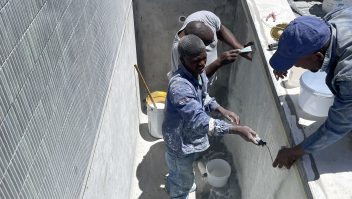Plus: How to Install a Salt Chlorine Generator in Your Cape Town Pool
Salt chlorine generators (also known as salt chlorinators) have revolutionised pool care across the Western Cape. They turn regular table salt into chlorine, keeping your water clean without the hassle of manual dosing.
But how long does it take for a salt system to produce chlorine? And can you install one yourself?
This Pools Reno guide breaks it all down:
- How fast a salt chlorine generator works
- How to install a salt system in your pool
- Internal/external resources, expert tips, and FAQs
How Fast Does a Salt Chlorine Generator Make Chlorine?
On average, a salt chlorine generator takes 1 to 4 hours to begin effectively producing chlorine, depending on these factors:
Key Influences:
- Water temperature: Colder water slows down chlorine production
- Salt levels: Ideal salt levels are 2,500–4,000 ppm (parts per million)
- Pump runtime: Chlorinators only work when your pool pump is on
- Generator output setting: Set between 50–100% depending on pool needs
Tip:
To maintain a free chlorine level of 1–3 ppm, most systems should run 6–8 hours/day in summer, and 4–6 hours/day in winter in Cape Town.
How to Install a Salt Chlorine Generator
Installing a salt chlorine generator is a smart way to automate your sanitation process. You can DIY if you’re confident with basic plumbing and wiring—or call Pools Reno to handle it safely and professionally.
Tools You’ll Need:
- Salt chlorinator unit (control box + cell)
- PVC saw and piping tools
- Drill and mounting screws
- Pipe glue and primer
- Electrical tools
- Salt (non-iodised pool salt)
Step-by-Step Installation Guide
1. Choose the Location
Install the chlorinator cell after the filter and heater, but before any chemical feeders.
2. Cut and Fit the Plumbing
Use PVC pipe to fit the salt cell inline with your return plumbing. Ensure proper flow direction.
3. Mount the Control Box
Install the control unit at eye level, near your pump and filter. Avoid direct sunlight or rain.
4. Wire the System
Connect the chlorinator to your pool pump timer or power source. Always switch off the circuit breaker before starting.
5. Add Salt to the Pool
Add the correct amount of salt based on your pool size. For example:
- 20,000L pool: ± 6 x 25kg salt bags
- 50,000L pool: ± 15 x 25kg salt bags
Mix thoroughly and allow 24 hours to fully dissolve.
6. Start the System
Turn on the pump and chlorinator. Monitor the control panel for correct salt levels and output settings.
Pros of Salt Chlorine Generators
- Low maintenance: No more manual chlorine dosing
- Softer water: Saltwater feels better on skin and eyes
- Cost savings: Long-term reduction in chemical purchases
- Eco-friendly: No chlorine handling or storage needed
Internal Links
External Resources
FAQ
Q: How much does a salt chlorine generator cost in South Africa?
A: Expect to pay between R7,000 – R15,000, depending on the brand and pool size.
Q: Can I use regular table salt?
A: No. Use non-iodised, coarse pool salt designed for chlorinators.
Q: What happens if the salt level is too low?
A: The system will stop generating chlorine and may show a low salt error. Add more salt and retest after 24 hours.
Q: How often should I clean the chlorinator cell?
A: Every 3–6 months, depending on your water’s calcium hardness.
Ready to Upgrade to a Salt Pool?
At Pools Reno, we supply and install high-quality salt chlorine generators in Cape Town and across the Western Cape. Let our experts help you choose the best system for your pool size, budget, and lifestyle.
Get your free quote today and enjoy crystal-clear water the easy way!



